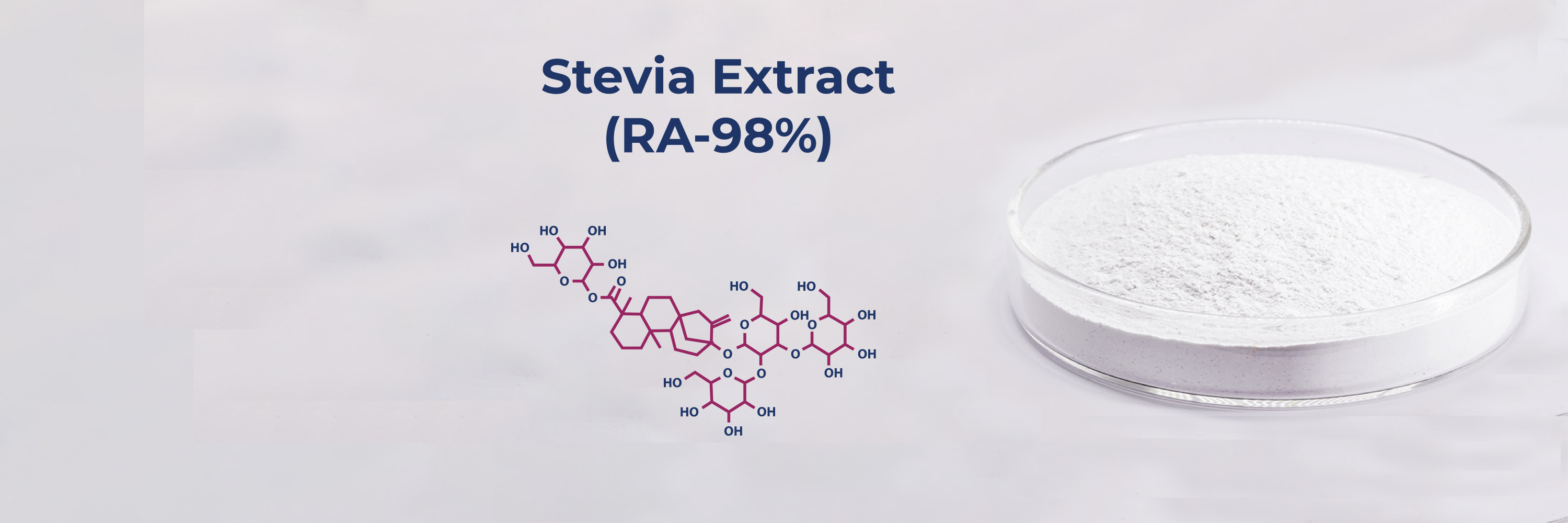INTRODUCTION
Stevia extract with Rebaudioside A (98%) is one of the sweet tasting steviol glycoside, extracted and purified from Stevia rebaudiana (Bertoni) – a small perennial shrub also known as “Honey leaf”. The leaves of S. rebaudiana contain more than 30 different steviol glycosides, among which stevioside and rebaudioside A are present in the highest levels. It is non-nutritive and tastes approximately 200-300 times sweeter than sucrose.
MANUFACTURE
Extraction process using water / alcohol (food grade) OR Bioconversion with the use of enzymes OR Glucosylation OR Fermentation.
| Synonym | Steviol Glycoside |
| Botanical Name | Stevia Rebaudioside |
| Part Used | Leaves |
APPLICATIONS
| Therapeutics : It is reported to be safe for consumption, do not produce toxic substances inside the body that are not associated with any health risks. Studies have demonstrated below positive effects on human health: |
|---|
| Antidiabetic |
| Antihypertensive |
| Anticancer and Antitumor |
| Antimicrobial Activity |
| Anti-caries |
| Antioxidant |
| Weight Management |
| Food Industry : Stevia extract (RA-98%) has emerged as zero-calorie sweeteners and can replace sugar in various industries as mentioned below : |
|---|
| Dairy products |
| Bakery products |
| Beverages |
| Juice and nectar drinks |
| Jellified goods |
SPECIFICATIONS
| Test | Unit | Specifications |
|---|---|---|
| Appearance | – | Fine Powder |
| Odor | – | Characteristic |
| Taste | – | Characteristic |
| Color | – | White |
| Loss on drying | % | ≤8.0 |
| Bulk Density (Tapped) | gm/ml | 0.2 – 1.0 |
| Assay (Rebaudioside A) | % | ≥ 98.0 |
| Heavy Metals | ppm | NMT 10 |
| Arsenic | ppm | NMT 2 |
| Cadmium | ppm | NMT 1 |
| Lead | ppm | NMT 2 |
| Mercury | ppm | NMT 1 |
| Microbial Test | ||
| Total Plate Count | cfu/gm | 10,000 |
| Yeast & Mold | cfu/gm | 1000 |
| E.coli | – | Should be Absent |
| Salmonella | – | Should be Absent |
| Staphylococcus aureus | Per 25 gm | Should be negative |
PACKING
25 kg HDPE Drum
STORAGE
Keep containers tightly closed in a dry, cool and well-ventilated place.
CERTIFICATIONS
WHO-GMP, ISO 22000, HACCP, Kosher, Halal & FAMI-QS
No matter the quantity you need, our exceptional quality and service will make ExSyn your supplier of choice! If you need any additional information or SDS, please contact us.
Iodine is anon-metallic, dark-grey/purple-black, lustrous, solid element. It is the heaviest and the rarest of stable halogens that can be found on the crust of earth.About fifty percent of all iodine produced and manufactured worldwide is used to form Organoiodine compounds. Iodine is an important element for many health-sustaining processes and essential for human thyroid health.
The product, acronymed Oct-NBE, is an organic compound with a cyclic ring system and a 8-membered hydrophobic chain. The structure renders the chemical special properties leading to its applications in diverse fields.
Nicotine is a hygroscopic, colorless to slight yellow, oily liquid, that is readily soluble in alcohol, ether or light petroleum. It is widely used recreationally as a stimulant and anxiolytic.
The product, acronymed ETD, is an organic compound with a fused bicyclic ring system and an ethylidene group. The structure renders the chemical special properties leading to its applications in diverse fields.
Sodium perchlorate monohydrate is the inorganic compound with the chemical formula NaClO4•H2O. It is the common existence form of sodium perchlorate, which can gradually absorb water in the air to form the monohydrate. Sodium perchlorate monohydrate is white rhombic crystal which is highly soluble in water and in alcohol. Its capacity to undergo redox reactions, liberating oxygen atoms, has been harnessed in the preparation of specialty chemicals, including pharmaceutical intermediates and fine chemicals.
Triphenylphosphine is a common organophosphorus compound that is frequently abbreviated as PPh3 or Ph3P. It is widely used in organic and organometallic compound synthesis because it is an effective reducing agent as well as a neutral ligand. At room temperature, PPh3 crystals are relatively air-stable and colourless.
Potassium chlorate holds significant importance across various industries due to its diverse applications. This white crystalline compound has been utilized for centuries as an essential ingredient in the production of matches, fireworks, and explosives, owing to its ability to release oxygen upon decomposition.
Podophyllotoxin is a non-alkaloid toxin lignan extracted from the roots and rhizomes of Podophyllum species. It is an organic heterotetracyclic compound that has a Furonaphthodioxole skeleton bearing a 3,4,5-trimethoxyphenyl substituent.
Octadecylphosphonic acid (ODPA), a versatile chemical compound, serves as a surfactant and dispersant in applications spanning coatings, lubricants, and corrosion inhibition. With its hydrophobic octadecyl chain linked to a phosphonic acid group, it excels in surface modification, boosting adhesion in metal surfaces.
